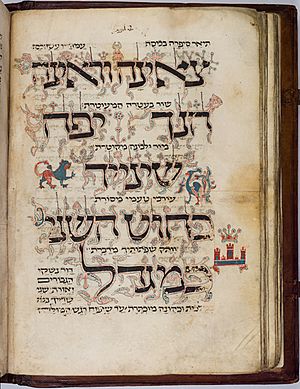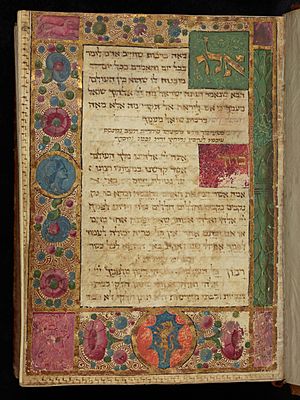Machzor facts for kids
The machzor (say: mahkh-ZOR) is a special prayer book used by Jewish people during important holidays. It's mainly used for the High Holy Days like Rosh Hashanah (the Jewish New Year) and Yom Kippur (the Day of Atonement). Many Jews also use different machzorim for other big festivals like Passover, Shavuot, and Sukkot.
Think of a machzor as a special version of a regular siddur. A siddur is a prayer book used for everyday prayers and on Shabbat (the weekly day of rest). The word machzor means "cycle" in Hebrew, because it contains prayers for holidays that happen every year in a cycle.
Originally, a machzor was a book with prayers for the whole year, including weekdays and Shabbat. Later, especially in Ashkenazi communities, people started using a siddur for daily and Shabbat prayers, and a machzor just for holiday prayers.
Why Machzorim Are Special
Some of the first Jewish prayer books appeared around the 900s. These books had a set order for daily prayers. But holiday prayers are very different from everyday prayers. So, early rabbis saw the need for a special book just for holidays. This is how the first machzorim were created.
Poems and Melodies
A machzor doesn't just have the usual prayers. It also includes many piyyutim (say: pee-yoo-TEEM). These are special poems written just for the holiday the machzor is for. Many prayers in the machzor, even ones said daily or weekly, have unique melodies. These melodies are only sung on the holidays. Most machzorim only have the words, not the music. The melodies are very old and have been passed down by people singing them.
Popular Machzor Versions
Over time, many different versions of the machzor have been created. These versions often have different translations, notes, or even different selections of poems. Here are some examples of popular machzorim:
- Koren Sacks Machzor Series – These books combine Hebrew text with English translations and comments by Chief Rabbi Jonathan Sacks. They also have prayers for the State of Israel and its defense forces.
- ArtScroll Machzor – This is a very popular machzor used by many Jewish communities. It includes English translations, explanations, and even instructions on when to sit or stand during prayers.
- Machzor HaShalem – Edited by Philip Birnbaum, this machzor was widely used for over 50 years. Many congregations still use it today.
- Roedelheim Machzorim – These machzorim were first printed in the early 1800s. They are still used in some communities and come in different versions.
- Daniel Goldschmidt/Jonah Fraenkel Machzor – This is a more academic machzor. It includes poems found in old manuscripts and has detailed notes.
- Machzor for Rosh Hashanah and Yom Kippur – Edited by Jules Harlow, this was the main machzor for the Conservative movement for many years.
- Machzor Lev Shalem – This is the newer official machzor for the Conservative movement. It includes many traditional prayers and offers different comments from rabbis. It also has gender-sensitive translations.
- Gates of Repentance – This was the main prayer book for the Reform movement for a long time. It includes many readings and translations.
- Mishkan HaNefesh – This is a newer Reform Jewish prayer book for the High Holy Days. It includes modern language and different ways to refer to God.
See also
 In Spanish: Majzor para niños
In Spanish: Majzor para niños



